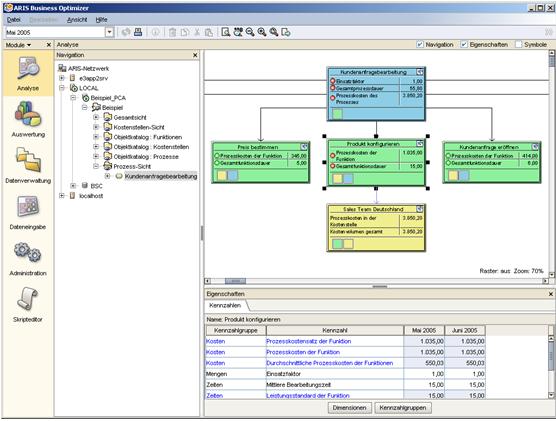While my last article explained how to determine your process costs and times by means of ARIS scripts, I will now provide information on how to obtain an exact calculation of the process costs by using ARIS Business Optimizer.
The problem that needs to be solved for every process is to find out what are the individual cost items and to determine the amount of costs for the functions and cost centers. ARIS Business Optimizer provides a rules set that you can use to this effect.
The Process Cost Analysis (PCA) rule set provides two calculation methods ('bottom up' and 'top down') that are based on the same modelling structure.The rule set can be used for the following model types:
- Value-added chain diagram
- EPC
- EPC (column display)
- EPC (row display)
- EPC (table display)
- Process chain diagram
- Office process
- Industrial process
- Value-added chain diagram
The 'top down' calculation method generally uses ACTUAL data and serves to distribute the costs incurred in the past.
Procedure:
For cost center analysis, the cost volume is allocated to functions according to the performance of the cost centers. All functions of the cost center under analysis are recorded. This allows you to determine which functions and processes actually caused the costs.
In contrast, the 'bottom up' calculation method is used to define an optimal target value.
Procedure:
The resource consumption of the elementary functions is evaluated using the cost rate for the assigned cost centers. The costs of the functions are aggregated to give the costs of the subprocesses and main processes. In this way, the costs of future processes can be planned and the effects of process changes evaluated.
In addition, the PCA (Process Cost Analysis) rule set provides 6 views that allow for different approaches to process cost analysis:
- The Overall view contains all processes, functions, connections, cost centers, and superior cost centers in their hierarchical structure.
- The Cost center view contains all relevant cost centers, connections, and functions in their hierarchical structure.
- Object catalog - Functions contains all analysis objects of the Function type.
- Object catalog - Cost centers contains all analysis objects of the Cost center type.
- Object catalog - Processes contains all analysis objects of the Process type.
- The Process view contains all processes, functions, connections, and cost centers in their hierarchical structure.
The rule set not only serves to calculate KPIs, but also provides the option of visualizing these by means of templates. These templates support KPI analysis.
Cost analysis done with ARIS Business Optimizer can thus be used for planning, controlling, and allocating costs within a company. This analysis provides answers to the following questions:
Process times:
- How long does a process take from a resource capacity point of view?
Process costs:
- What costs accrue during the execution of a process or of entire process chains aiming at creating products or services?
Resource requirements:
- How many resources are required for performing the relevant processes?
- How many resources of a specific resource type are required, e.g., of type 'employee'?
- What is the degree of utilization of available resources?
Example of a 'bottom up' calculation:
The following model section is taken from my "Chocolate-Chili-Gingerbread" recipe:
Two functions exist that are both carried out by one and the same organizational unit, which is "me". To be able to calculate the process costs the following information is required:
Cost rate = 10.00 Euro/hour
Average processing time = 0.13 hours
Usage factor (number of function executions)= 1.00
Average processing time = 1.00 hour
Usage factor = 1.00
Now the process costs for the function will be calculated:
The process cost rate of the function consists of the average processing time, the cost rate, and the usage factor and has the following values:
- 1.30 Euro for "Go to the supermarket" and
- 10.00 Euro for "Buy the ingredients"
The process costs are made up of the sum of all functions. The result is: 11.30 Euro.
Of course this is a very simple example of how to calculate processes. If you want to perform a process calculation for processes with multiple cost factors, you can use the KPI editor to create and use your own KPIs. If customizing the modeling structure is required you can contact the Customized Solutions department.
As a conclusion, we can say that using the PCA rule set has the following advantages:
- visual representation based on templates
- possibility of defining your own KPIs
- possibility of defining your own modeling structure
- exact calculation of KPIs












Mojtaba Hedayatinia on
Thank you Eva for this post and the rest of your useful posts.